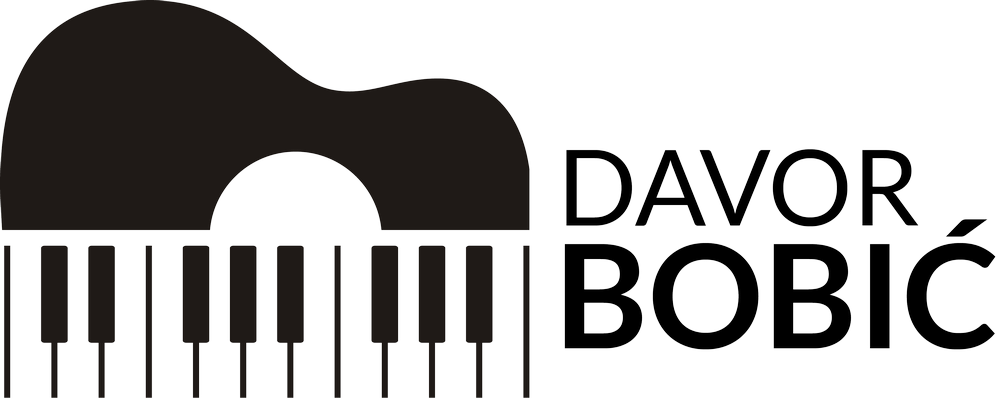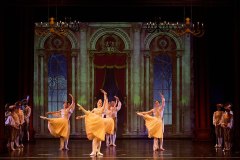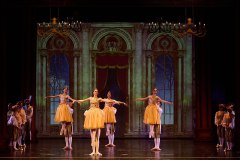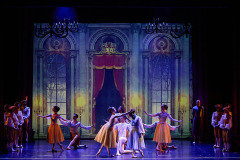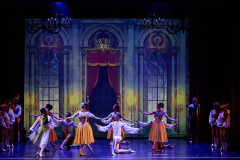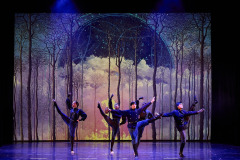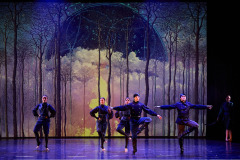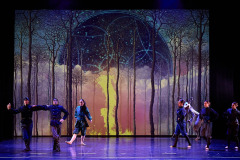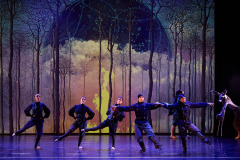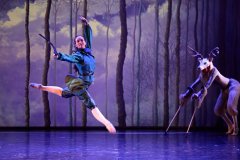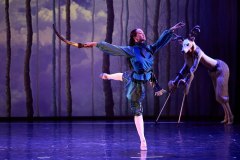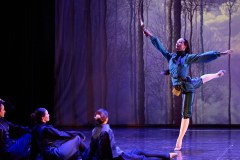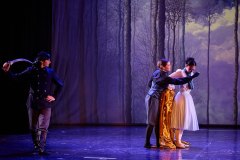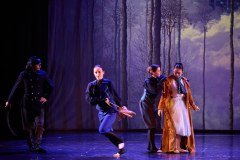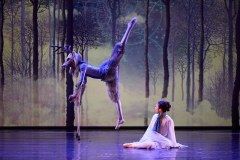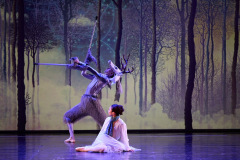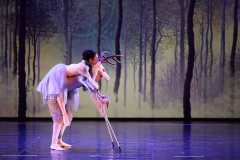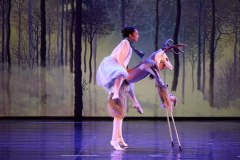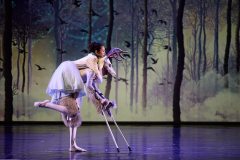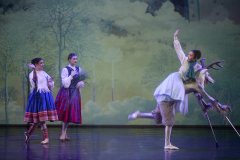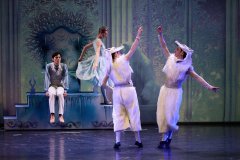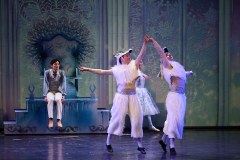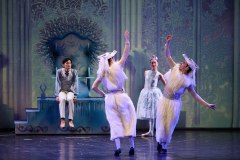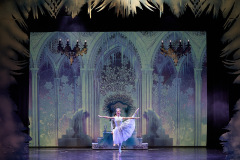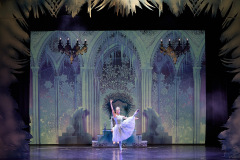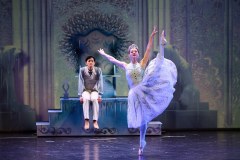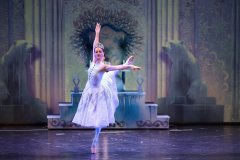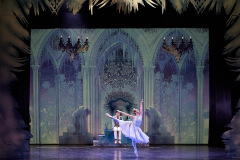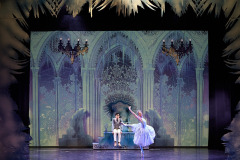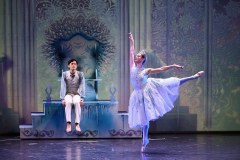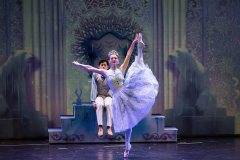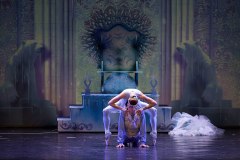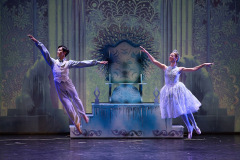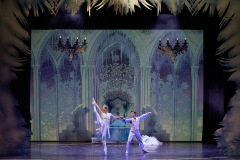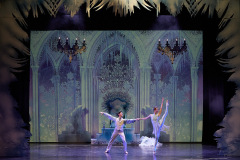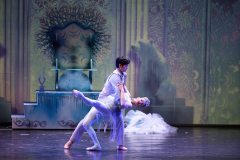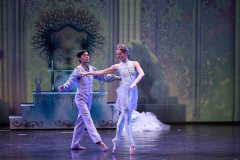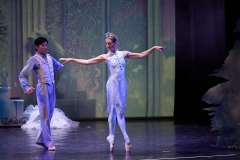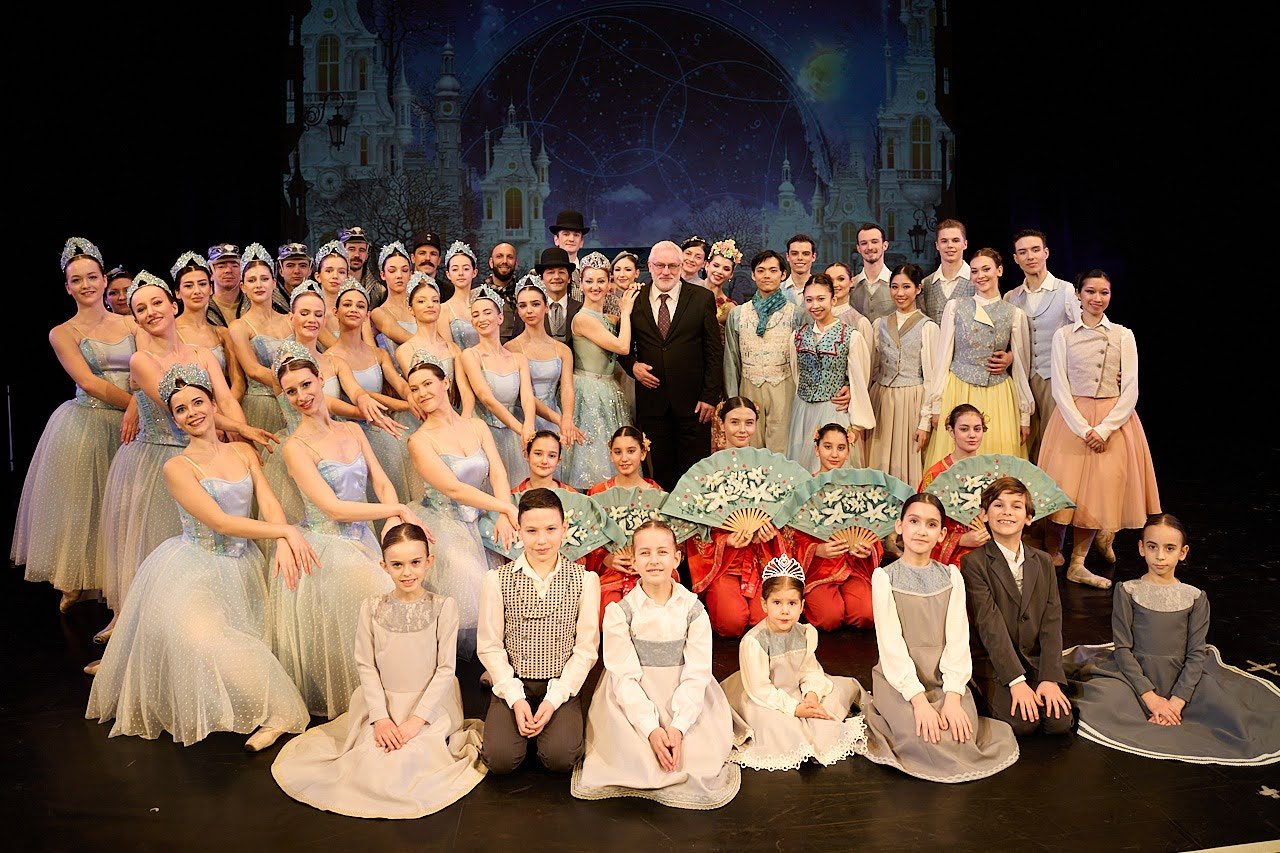

(Snedronningen)
coproduction HNK u Osijeku i HNK Split
Balet in two acts
Hansa Christiana Andersen
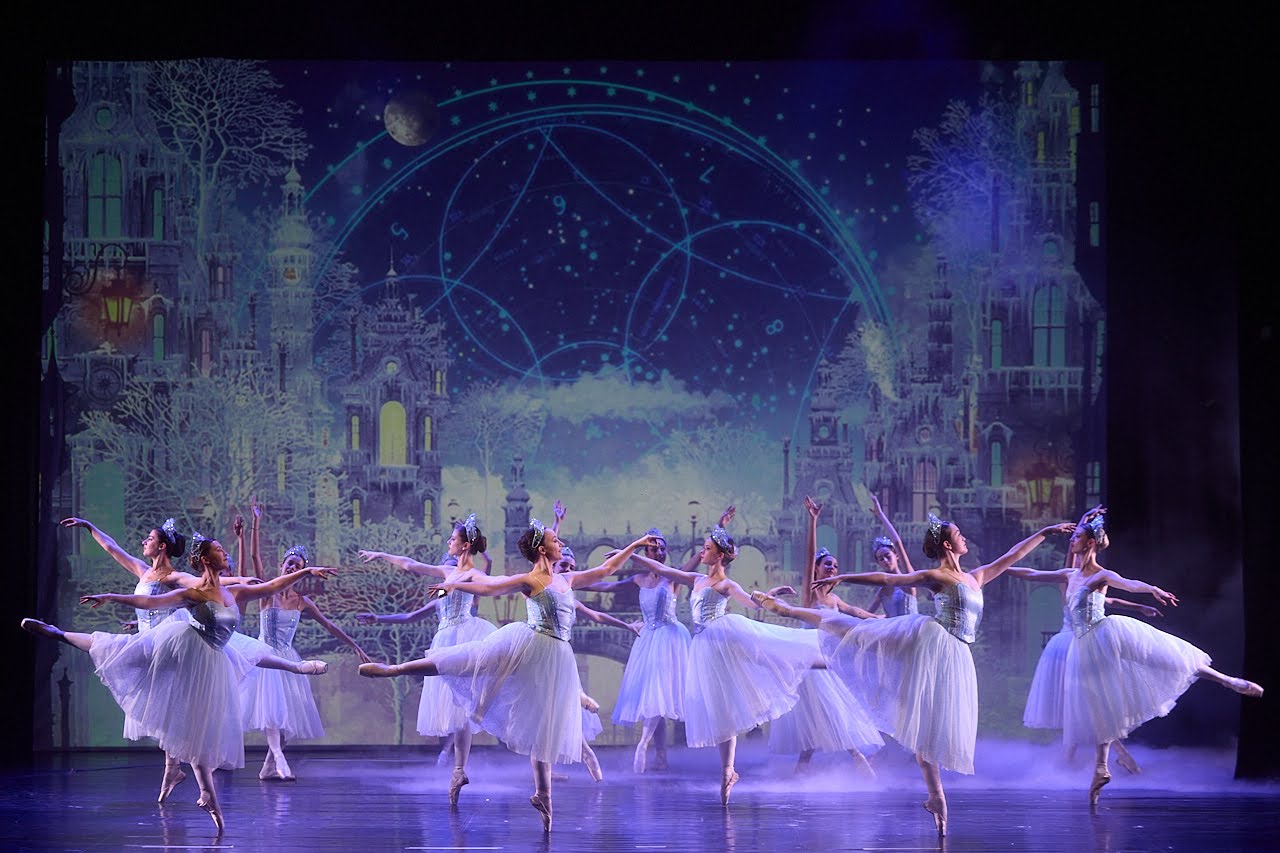

AUTHORS
Composer – Davor Bobić
Conductor – Stjepan Vuger
Choreographer and Director – Svebor Sečak
Costume and Set Designer – Neven Mihić
Light Design – Tomislav Kobia
Animations and Video – Zdenko Bašić and Franko Dujmić
Ballet Masters – Sara Epifany Erceg and Vuk Ognjenović (Osijek) / Albina Rahmatullina and Ivan Boiko (Split)
CAST:
SNOW QUEEN – IRINA ČABAN BILANDŽIĆ /ANIA MARIA BARTKOWSKY
GERDA – AMI INOUE / EVA KARPILOVSKA
KAY – TAKAFUMI TAMAGAWA / EMANUELE SARDO
WITCH – ANIA MARIA BARTKOWSKY / MATEA MILAS, ARISA HIRONO
CROW – JANA BRLETIĆ
FRIENDS – JELIZAVETA NADENENKO, JOSEPHINE MANSFIELD, VALERIE LIN, RIMI MIZOUKA / AMI INOUE, MATEA MILAS, ANIA MARIA BARTKOWSKY, DANYL PODHRUSKO, VALERII LIUBENKO, JAKE MILSTON, LEONARDO SOUZA / BENJAMIN COCKWEL, CHRISTIAN LAMANNA, VINCENT GERBET
LADY – SNJEŽANA HROVAT
GENTLEMEN – VUK OGNJENOVIĆ, GORDAN MARIJANOVIĆ
SALESWOMEN – MARIA HOLJEVAC, SENKA PETRA RONČEVIĆ, ZRINKA STILINOVIĆ
CHIMNEY SWEEP – SINIŠA IVANOVIĆ
POLICEMAN – BORIS STJEPANOVIĆ
CHILDREN – EMA HORVAT, EMA MIHALJ, MIHAELA PANDUREVIĆ, MILA SANTRIĆ, STRIBOR HRPKA, FILIP LUKAVEČKI, OLEG OGNJENOVIĆ, GAIA OGNJENOVIĆ
SNOWFLAKES – SARA EPIFANY ERCEG, MAJA FRANKIC, PETRA LUCIJA ŽIVKOVIĆ, DORA LUKETIĆ, LUCIJA FIRI, JANA BRLETIĆ, HELENA HORVAT, LUCIJA HORVAT, ANJA TEREK, LUCIJA VELIĆ, PETRA ROGULJIĆ, KATJA JELENIC, NADIA KALAFATIC, EMA JOZEFCAK, PARICIJA RONTA, TENA MADUNIĆ , DORA LOCI
TROLLS – DANIJEL NOVOSELAC, NEVEN LUCIAN DAVIDOVIĆ, ARMANDO ELHAG HASSAN, MIROSLAV KASUMOVIĆ
LITTLE ROBBER GIRL – JANA BRLETIĆ
ROBBERS (MEN) – VUK OGNJENOVIĆ, NEVEN LUCIAN DAVIDOVIĆ, VANJA DUŠIĆ
ROBBERS (WOMEN) – HELENA HORVAT, SARA EPIFANY ERCEG, LUCIJA FIRI / LUCIJA HORVAT, DORA LUKETIĆ, SNJEŽANA HORVAT
LAPPLAND WOMAN AND FINLAND WOMAN – PETRA LUCIJA ŽIVKOVIĆ, MAJA FRANKIĆ / DORA LUKETIĆ, SNJEŽANA HORVAT
RAINDEER – GORDAN MARIJANOVIĆ
PRINCESS – JELIZAVETA NADENENKO
PRINCE – DANIL PODHRUSKO
COURTIERS – JOSEPHINE MANSFIELD, VALERIE LIN, RIMI MIZOUKA, VALERII LIUBENKO, JAKE MILSTON, LEONARDO SOUZA / VINCENT GERBET, BEN COCKWEL, CHRISTIAN LAMANNA
PAGES – ANJA TEREK, LUCIJA VELIĆ, PETRA ROGULJIĆ, KATJA JELENIĆ, NADIA KALAFATIĆ, EMA JOZEFCAK, PARICIJA RONTA, TEA KOSANOVIĆ
FOOTMEN – SINIŠA IVANOVIĆ, BORIS STJEPANOVIĆ
LADIES-IN-WAITING – PETRA RONČEVIĆ, MARIJA HOLJEVAC, TENA MADUNIĆ, DORA LOCI / TEA KOSANOVIĆ
FLOWERS – JELIZAVETA NADENENKO, JOSEPHINE MANSFIELD, VALERIE LIN, RIMI MIZOUKA
SNOW WALTZ – ANIA MARIA BARTKOWSKY, SARA EPIFANY ERCEG, MAJA FRANKIĆ, PETRA LUCIJA ŽIVKOVIĆ, DORA LUKETIĆ, LUCIJA FIRI, JANA BRLETIĆ, HELENA HORVAT, LUCIJA HORVAT, ANJA TEREK, LUCIJA VELIĆ, PETRA ROGULJIĆ, NADIA KALAFATIĆ, EMA JOZEFČAK, PARICIJA RONTA, DORA LOCI, TENA MADUNIĆ, KATJA JELENIC, / MATEA MILAS, ARISA HIRONO
INDIAN HYACINTH – VUK OGNJENOVIĆ, LUCIJA HORVAT, HELENA HORVAT / SARA EPIFANY ERCEG
ASIAN JASMINE – ANJA TEREK, LUCIJA VELIĆ, PETRA ROGULJIĆ, KATJA JELENIC, NADIA KALAFATIC, EMA JOZEFCAK, PARICIJA RONTA, TEA KOSANOVIĆ, NIKA VUKOBRATOVIĆ, KATJA VUKOBRATOVIĆ, KARLA MEDIĆ, LARA KOVAČEVIĆ / DORA LOCI, TENA MADUNIĆ
EUROPEAN MORNING GLORY (HUSSARS) – DANYL PODHRUSKO, VALERII LIUBENKO, TAKAFUMI TAMAGAWA / JACK MILSTON, LEONARDO SOUZA
AFRICAN LILLY – GORDAN MARIJANOVIĆ (MEDICINE MAN), DANIJEL NOVOSELAC (FIRE EATER), ARMANDO EL-HAG HASSAN (DRUMMER), MIROSLAV KASUMOVIĆ (DRUMMER)
CROATIAN ROSE – SNJEŽANA HORVAT, LUCIJA FIRI, DORA LUKETIĆ / HELENA HORVAT, VUK OGNJENOVIĆ, VANJA DUŠIĆ, NEVEN LUCIAN DAVIDOVIĆ
NUMBER ORCHESTRATION: BOŽO BANOVIĆ
KAY AND THE SNOWFLAKES – THE WOMAN SKILLED IN MAGIC – THE INDIAN DANCE – THE HUSSAR DANCE – THE CROATIAN DANCE – THE MARCH
HUMORESQUE / THE DRUNKEN ROBBERS
PROJECT ASSOCIATE – VUK OGNJENOVIĆ
STAGE MANAGER – IRENA BUDAK
CONCERT MASTERS – IGOR ŠIMONJI AND BÉLA NAGY
PARTICIPANTS: THE BALLET ENSEMBLE AND THE ORCHESTRA OF OSIJEK HNK, THE BALLET DANCERS OF SPLIT HNK, THE OSIJEK HNK BALLET STUDIO AND THE FRANJO KUHAČ MUSIC SCHOOL – THE CLASSICAL BALLET DEPARTMENT.
TECHNICAL MANAGER – MATO IVIĆ
STAGE MANAGER – ŽELJKO PLJUSKOVAC
MASK AND HAIRDRESSER’S WORKSHOP MANAGER – RUŽICA MILER
SOUND MANAGER – DAVORIN TOTH
PAINTER – LEON LANDEKA
DECOR AND STAGE EQUIPMENT MADE IN THE HNK WORKSHOP MANAGED BY ŽELJKO JURIĆ
COSTUMES MADE IN THE HNK TAILORING WORKSHOP MANAGED BY GORDANA JURKOVIĆ
COSTUME DESIGN ASSISTANTS – IVANA BAŠIĆ AND BRUNO OSMANAGIĆ*
STAGE PROPS ASSOCIATE – LAURA RELJAN*
HEADGEAR BY IVANA BAŠIĆ AND BRUNO OSMANAGIĆ
TIARAS AND HEAD ORNAMENTS BY NEVEN MIHIĆ
STUDENTS OF THE ACADEMY OF ART AND CULTURE IN OSIJEK*
PREMIERE: 16 FEBRUARY 2024
BALLET SYNOPSIS
ACT I
The main town square
In the hustle and bustle of the town square, Gerda and Kay are having fun with their friends.
The mirror scene
The Trolls create a magic mirror that distorts reality and raise it to the sky where the mirror shatters into tiny fragments scattering all over.
Gerda and Kay
Gerda and Kay’s friendship and affection grow into young love. Kay gives Gerda his scarf as a pledge of his affection.
Snowflakes and the first appearance of the Snow Queen
Kay remains alone in the square as it starts to snow. A vision of the Snow Queen appears among the snowflakes, throwing fragments of the broken mirror through the snow and the shards get into Kay’s eye.
The lively scene of the main town square covered in ice
Kay touches his eye and heart for a moment, but the discomfort soon wears off and he joins his friends in the game on the frozen town square. Gerda slips and falls.
The Snow Queen kidnaps Kay
As the friends approach Gerda to pick her up, Kay displays a change of character, laughing and mocking her fall, somewhat aggressively pushing his friends and Gerda away. The vision of the Snow Queen creating a snow blizzard reappears. When everyone but Kay scatters, she arrives with the Trolls on a sleigh. Kay is enchanted by her appearance and takes the children’s sled and hooks it to the Snow Queen’s sleigh. The Queen takes him to her distant kingdom, over forests and mountains.
Gerda’s prayer
Gerda is alone and is grieving Kay’s disappearance, wearing his scarf around her neck. She is praying for his return.
The Enchantress
The Enchantress appears and creates a flower garden amid winter. The flowers come alive and dance the Flower Waltz together with Gerda and the Enchantress. Although impressed, Gerda remembers Kay and asks the Enchantress for help. In search of Kay, the Enchantress takes Gerda through several continents and countries with the help of a globe and magical flowers: Indian Hyacinth, European Morning Glory, Asian Jasmine, African Lily, and Croatian Rose.
Gerda sets off on a journey with the Crow
Gerda wants to continue her search, so the Enchantress gives her a magic Crow. Gerda and the Crow set off on a journey over hills, through forests and valleys and eventually reach a beautiful palace.
ACT II
The Princess Palace
The ball inside the palace is interrupted by Gerda’s arrival.
Dreams and lamps
The Prince and the Princess host Gerda and give her jewellery, a fur coat, a fur hat, and other gifts and allow her to spend the night in a huge bed where she dreams about Kay.
The Robbers
In the nearby forest, the drunken Robbers gather around the campfire, led by the Little Robber Girl, leading the captive Reindeer.
The Robbers rob Gerda
Gerda arrives on a horse dressed in the rich clothes she received in the palace. The Robbers capture her and rob her, and the Little Robber Girl saves her life, protecting her and preventing the worst from happening, and eventually sets off with the Robbers. Gerda remains alone and robbed.
The Reindeer and Gerda – a journey through snow blizzards
The Reindeer left behind by the Little Robber Girl approaches Gerda, who deftly mounts the Reindeer to continue their journey through the snow and icy expanses towards the far North. Exhausted, they meet a Lapland woman and a Finland woman who help them, provide them with water and food, and then they continue their journey toward the Snow Queen’s palace.
The Snow Queen’s palace
At the same time, in the Snow Queen’s palace, the Queen seduces Kay with a dance and eventually uses her powers to freeze him under her throne and leaves.
Gerda enters the Snow Queen’s palace
Gerda arrives at the palace, enters, wanders through the ghostly corridors and icy halls, and reaches the hall with the frozen throne.
Duet by Gerda and Kay
Gerda approaches Kay and realizes in horror that he has been frozen. Her love and warm tears melt Kay and his frozen heart. Kay pledges his loyalty to Gerda, feeling remorse for his actions. They declare their eternal love to each other.
The Snow Waltz
The Snow Queen appears and, together with the snowflakes, attempts to freeze Gerda and Kay again, however, owing to their love, the ice slowly melts and vanishes, everything thaws and the sun starts shining.
Town square
In the town square, everything is back to normal. Gerda and Kay dance together with their friends, richer for the life experience that has reinforced their love.
Note: there is no intermission between the acts.

HANS CHRISTIAN ANDERSEN was a Danish writer born in Odense on 2 April 1805. His life can be described as a permanent struggle and desperate effort, which was an important character trait in his (unfairly) slow rise to literary recognition. He was only fourteen years old when he left his mother’s home, a cobbler’s widow and laundress, in order to study in a theatre school with ballet and singing in Copenhagen, from which he was dismissed as “untalented”.
Nevertheless, he managed to graduate in university studies and, while still a student, under Hoffman’s influence, published the imaginative prose arabesque Walking from the Holmen Canal to the Eastern Cape of Amager (1830). Andersen was an intrepid traveller: first across his homeland, and then throughout Europe. The work that brought him success and recognition was the novel The Improviser (1835), which was almost instantly translated into a wide range of languages. The public and critics, however, did not pay special attention to his nowadays famous work Fairy Tales, Told for Children (1835-37), as well as to the sequel New Collection (1838-41), although these are the works that have placed him among the ranks of the world’s most famous writers. By the end of his life, Andersen wrote a total of 156 fairy tales and related realistic stories that were written both for adults and children.
Andersen died in Copenhagen, in August 1875, as an honorary professor and an honorary citizen of his native Odense.
DAVOR BOBIĆ, composer
Composer, pedagogue, organizer and long-time director of the Varaždin Baroque Evenings, Davor Bobić is undoubtedly one of the most influential musicians of contemporary Croatian musical life. Born in Varaždin, in 1968, where he finished primary and secondary school, he graduated in accordion, composition and musical theory at the P. I. Tchaikovsky Conservatory in Kiev. He started his teaching career immediately upon completion of his studies at the Varaždin School of Music. He continued his teaching career at the Academy of Arts in Osijek, first as assistant professor as of 2003, then as associate professor as of 2014, and as a full professor with tenure since 2022. In 2009, he was appointed Vice-Dean for Science and Art at the same institution, and from 2018 to 2022 he held the position of Advisor to the Dean. In addition to a series of organizational improvements, under his management or with his participation, the number of study programmes at the Academy of Arts and Culture of the J. J. Strossmayer University of Osijek, increased (piano, composition, music theory, guitar, music therapy), and a completely new one was introduced (tamburica). At the Varaždin Music School he will first and foremost be remembered for the fact that, in the mid-nineties, he was the first in Croatia to start a composition course for primary and secondary students. While he held the position of the Director of the Concert Agency – from 1999 to 2007 – Varaždin had a continuous musical season, rare in its history, and when he took the reins of the Varaždin Baroque Evenings in 2006, he changed the concept of the Festival to reflect contemporary notions of early music. He is one of the initiators and the artistic director of the Osijek Music Wednesday Concert Cycle from 2012 to 2021.
The opus of Davor Bobić, with more than 200 written compositions, is one of the most extensive, diverse and most frequently performed ones in contemporary Croatian music. It includes instrumental, vocal, vocal-instrumental and musical-stage works. Among the more extensive vocal-instrumental works are the oratorios: King Tomislav, Isaiah, Cantata; Jericho and Amida, and the Requiem for Vukovar symphony. Among the musical-stage works, there is Veronika Desinićka – ballet with singing parts. He has also written movie music and music for several theatre pieces.
Davor Bobić won many of the most prestigious professional and state awards. He is the Composer in Residence of the Dubrovnik Symphony Orchestra for 2022 and 2025, and has the status of Composer in Residence at the Croatian National Theatre in Osijek for ballets for the period from 2023 to 2027. In the academic year 2022/2023 he was the Composer in Residence at the University of Wisconsin of River Falls in the USA as the first foreign composer in the history of the said university.
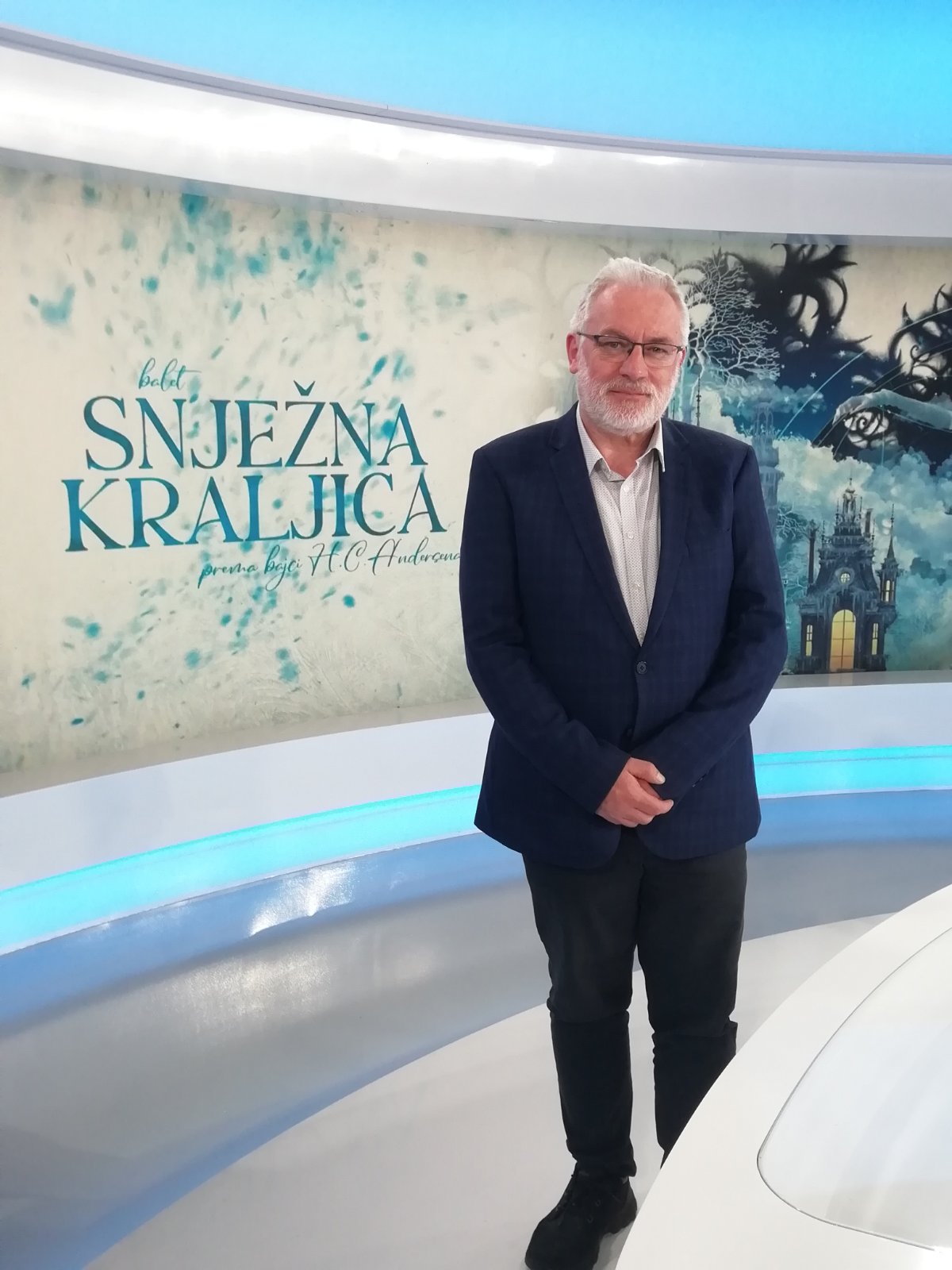
SNJEŽNA KRALJICA
Čast je i velika radost biti dijelom ovog projekta, moguće i prvog u smislu originalno pisanog baleta za HNK u Osijeku u njegovoj bogatoj povijesti. „Snježnu kraljicu“ sam odlučio jednog dana napisati još za vrijeme moga studija na poznatom Državnom konzervatoriju P. I. Čajkovski u Kijevu, a to je bilo davno, otprilike prije gotovo 30 godina gdje sam imao neopisivu privilegiju prisustvovati velikim baletnim i opernim produkcijama u Teatru opere i baleta Taras Ševčenko. Iako sam balet naumio pisati prošle godine u okviru programa europske mobilnosti nastavnika Erasmus+ na čuvenom Konzervatoriju N. R. Korsakova u Sankt Petersburgu, sudbina je htjela
da ovo zahtjevno djelo dovršim u Osijeku. Svjetski poznata bajka kompleksna je psihološkog sadržaja protkana mnogim nedoumicama, propitkivanjima da ne kažem zamkama te prožeta dubokim kršćanskim uvjerenjem H .C. Andersena što je meni kao autoru glazbe predstavljalo poseban izazov najviše u smislu da pokušam djelo približiti – kako djeci – tako i odraslima. U pisanju baleta po ovoj nadasve popularnoj bajci okušali su se dosad skladatelji Kenji Bunch i Tuomas Kantelinen dok je u Škotskoj aktualna verzija koja je nastala prema glazbi N. R. Korsakova. Duboko sam uvjeren da promišljenim pristupom ovoj zajedničkoj viziji kao rezultat suradnje s uglednim hrvatskim koreografom Sveborom Sečakom je nastalo novo, velebno ostvarenje protkano iznimnim dramaturškim sadržajem, prožeto iskrenim osjećajima koje će zasigurno odaslati snažnu poruku današnjem poimanju svijeta. Želim zahvaliti novoj Upravi HNK u Osijeku na čelu sa intendantom Vladimirom Hamom te ravnateljem Opere Ladislavom Vrgočem na podršci i njihovom hrabrom pružanju prilike da predstavim publici i javnosti ono najbolje što mi je usađeno na školovanju u tadašnjem Sovjetskom savezu. Također zahvaljujem voditelju Ansambla baleta osječkog HNK, Vuku Ognjenoviću na ukazanom povjerenju.
red. prof. art. Davor Bobić
A WORD BY THE CHOREOGRAPHER
It is both a great responsibility, as well as a pleasure, to set The Snow Queen ballet for the Croatian National Theatre in Osijek to the music of the Croatian composer Davor Bobić, under the baton of maestro Stjepan Vuger. While the opera ensembles in our national theaters nurture local opera literature such as the works of Ero s onoga svijeta (Ero the Joker) and Nikola Šubić Zrinski as well as the works by local contemporary composers, local ballets such as Đavo u selu (The Devil in the Village) and Licitarsko srce (The Gingerbread Heart) have not been performed for a long time, and the ballets to the music of contemporary Croatian composers are more of an exception than the rule. Certainly, the Osijek ballet ensemble is not able to implement such a project on their own; therefore, I welcome the decision by the directors of Osijek and Split Croatian National Theatres to enter into co-production through the K-HNK project of the Ministry of Culture and Media, the project that enables co-production and cooperation of national theatres and indirectly encourages domestic creativity. Furthermore, this ballet production is my attempt to contribute to the survival and development of Osijek Ballet with the desire to avoid the amplitude by which, by default, an ascending line is inevitably followed by a descending one. This is precisely why this ballet was included in the repertoire after the rather successful Nutcracker, as well as once the La fille mal gardée and Licitarsko srce with my choreography, in order to maintain the continuity of the ballet performances and avoid oscillations. The Osijek Ballet has had a rich history of over a century and still remembers artists who contributed to its development and prosperity, such as Stjepan Suhi and Argene Savin, and many artists who emerged from it, such as Antun Marinić, Slavko Pervan, Joža Komljenović, Antonije Maksimović and several others who had careers significant not only for Osijek and Croatia, but for the international scene as well.
Since the early 20th century, there have been many guest appearances, including the Froman Brothers’ ballet company and the Loie Fuller dance group, as well as our prominent international stars such as Mija Čorak Slavenska and Mercedes Goritz-Pavelić. Although the ballet ensemble was abolished in the seventies of the last century, the art of ballet still lives on in Osijek through the Annals of Chamber Opera and Ballet, founded by Dragutin Savin, who provided the Osijek audience with an insight into the current events of the world scene. In the 1990s, the dance ensemble was renewed owing to the needs of the Opera repertoire, and in the last twenty years there has been a clear desire to renew the ballet ensemble in the Croatian National Theater in Osijek, to which I have contributed by staging the ballet Licitarsko Srce by Krešimir Baranović under the baton of maestro Mladen Tutavac in 2005, and La fille mal gardée in 2015 under the baton of maestro Filip Pavišić, as well as repeatedly organizing guest appearances with performances such as Hamlet, The Merry Widows, Dance of the Cadets, etc. Today’s nucleus of the ballet ensemble is composed of home forces led by Vuk Ognjenović, and the number should certainly be increased in the future in order to further develop ballet art in Osijek, which, as a city with a rich history and being a Slavonic metropolis, should provide its citizens with Central European culture, which makes us an integral part of the European cultural circle.
Svebor Sečak
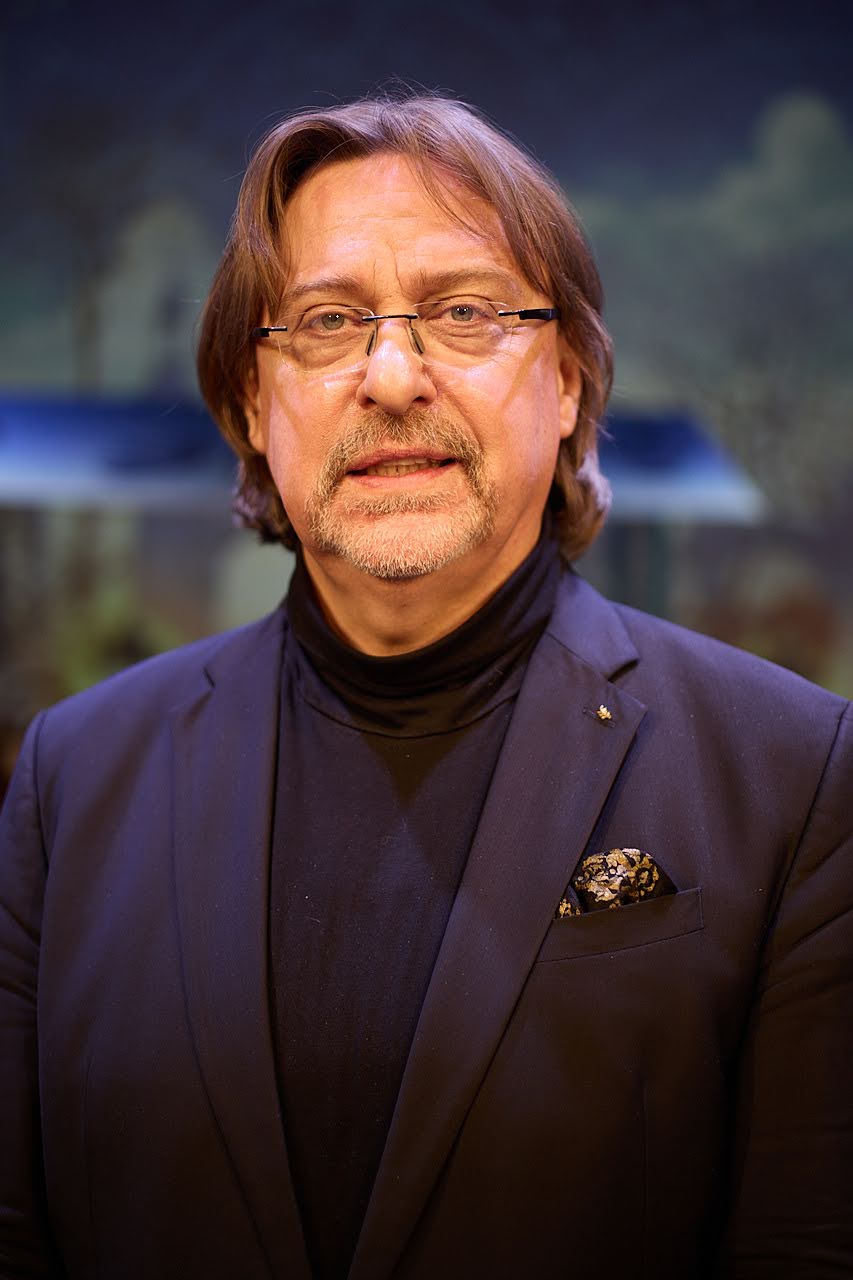

VIZIONARSKO PUTOVANJE U BUDUĆNOST
Vizionari su u svim segmentima društva sutvorci naše zajedničke stvarnosti. Kada se nekoliko takvih osoba nađe na jednom mjestu, uvijek je dobra stvar. Upravo se to i dogodilo kada je skladatelj Davor Bobić došao s prijedlogom za novi balet, s meni os obno najdražom bajkom iz djetinjstva. Odmah smo ga prihvatili i intendant Vladimir Ham, kao i moja malenkost te smo na prijedlog ravnatelja Opere Ladislava Vrgoča koreografsku palicu prepustili istak-
nutom borcu za baletnu profesiju Sveboru Sečaku. Gospodin Sečak, osim što je već koreografirao dva baleta u Osijeku, Licitarsko srce i Vragolastu djevojku, svjestan je da je ova praizvedba svojevrsna zadnja linija obrane hrvatskoga baleta.
Etablirajući balet u Osijeku, postupno tijekom zadnjih petnaestak godina posredno sam i neposredno, uz pomoć divnih mladi ljudi s kojima plešem
svaki dan uspio stvoriti prilike u kojima grad Osijek danas ima BALETNI ANSAMBL, BALETNI STUDIO, BALETNU ŠKOLU, BALETNI REPERTOAR, i ono najbitnije BALETNU PUBLIKU koja čini ovaj grad. Upravo zato mi je drago da je ministrica kulture i medija Nina Obuljen Koržinek podržala ovu koprodukciju kao viziju onoga što bi Balet u Osijeku mogao s recimo dvanaestak profesionalnih plesača zaposlenih unutar kuće. Stoga, veliko hvala intendantu splitskog HNK Vicku Bilandžiću te ravnatelju Baleta Pedru Carneiru na posudbi dvanaest izvrsnih plesača s kojima se nazire ideja kako bi balet u Osijeku mogao, trebao i morao izgledati u skoroj budućnosti.
Dakle, postojanje Baleta u Osijeku imperativ je današnjeg vremena. Osijek je grad koji je u ne tako dalekoj povijesti bio kulturno i gospodarsko središte, mjesto u kojem je skladan prvi hrvatski nacionalni balet Jela te samim time zaslužuje imati respektabilan baletni ansambl, u prvom redu financijski, a potom formalno i pravno.
izv. prof. art Vuk Ognjenović


